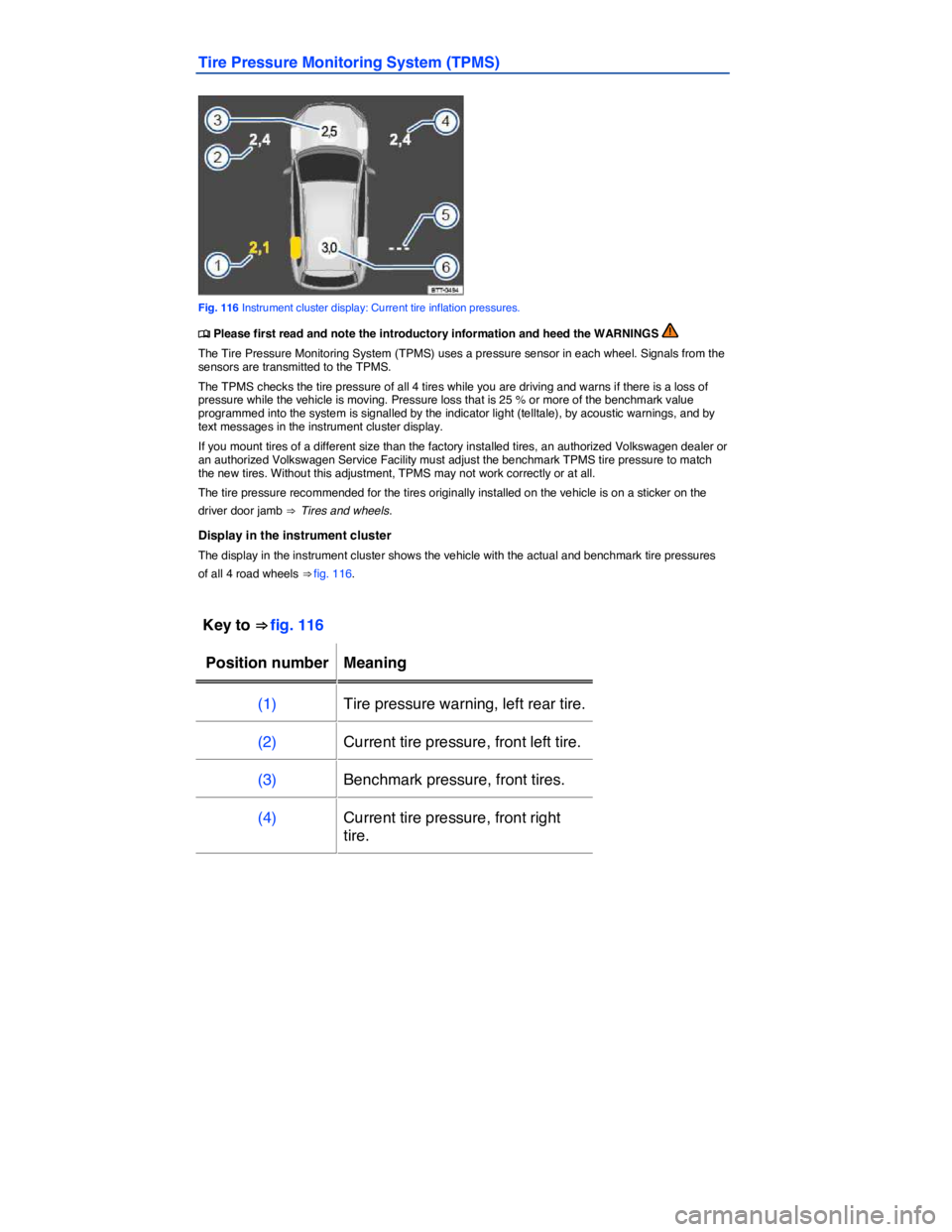2010 VOLKSWAGEN TOUAREG inflation pressure
[x] Cancel search: inflation pressurePage 205 of 684

may apply. See http://www.dtsc.ca.gov/hadardouswaste/perchlorate. Obey all applicable legal re-quirements regarding proper disposal.
Do not rely solely on the Tire Pressure Monitoring System (TPMS). Check your tires regularly to make sure they are properly inflated and have no signs of damage, such as punctures, cuts, cracks, and blisters. Remove any objects that become embedded in the tire tread but have not penetrated into the body of tire itself.
When you take delivery of the vehicle, the Tire Pressure Monitoring System (TPMS) is calibrated for the factory-recommended cold tire inflation pressure for the tires on your vehicle, as shown on the
label inside the driver door ⇒ fig. 111.
�x For replacement tires that require a different inflation pressure, the TPMS must be adjusted to the new pressure specification by an authorized Volkswagen dealer or an authorized Volkswagen Service Facility. Only one value can be entered for each tire partial or full load; see the tire inflation pressure
label on the driver door pillar ⇒ Tire inflation pressure.
�x To help prevent damage to the sensor and valve, do not put excessive force on the valve when checking the tire pressure. Do not try to bend the valve.
�x If sensors have to be replaced, have the valves changed at the same time.
�x The tire valve gaskets must be replaced whenever a tire is mounted on the rim. Your authorized Volkswagen dealer or authorized Volkswagen Service Facility has a valve seal and gasket kit for this purpose. Always make sure that a valve seal and gasket kit is also used whenever a sensor is re-placed.
�x If you have to adjust the tire pressure on a “warm” tire, fill the tire with 2.0 - 4.35 psi (20 - 30 kPa) more than the pressure specified on the tire pressure label.
�x When the TPMS determines that the air pressure in at least one tire is too low, carefully check the pressure in all 4 tires with an accurate tire pressure gauge. Low tire pressure usually cannot be deter-mined by looking at the tire. This is especially true of low-profile tires.
�x A Declaration of Compliance with the United States FCC and Industry Canada regulations is found on of this manual.
There may be differences between the pressure readings from a tire pressure gauge and the pressures registered by the Tire Pressure Monitoring System (TPMS). The electronic TPMS is more accurate.
If you have work done on your wheels or tires, inform the workshop that the vehicle is equipped with a Tire Pressure Monitoring System (TPMS) that has sensors in the wheels.
New tires may expand slightly the first time they are driven at high speeds, which can trigger a tire pressure warning. Remember that tire pressure can only be properly measured when the tire is
“cold” ⇒ Tires and wheels.
Indicator light (telltale) �
Page 208 of 684

WARNING
Incorrect tire pressures and/or underinflation can cause sudden tire failure, loss of control, collision, serious personal injury, or even death.
�x When the warning symbol �
Page 209 of 684

Tire Pressure Monitoring System (TPMS)
Fig. 116 Instrument cluster display: Current tire inflation pressures.
�
Page 210 of 684

Key to ⇒ fig. 116
Position number Meaning
(5) No data received, right rear tire.
(6) Benchmark pressure, rear tires.
If the tire pressure is too low, the relevant tires and the respective readings are shown in yellow
⇒ fig. 116.
Each tire, including the spare (if provided), should be checked monthly when cold and inflated to the inflation pressure recommended by the vehicle manufacturer on the vehicle placard or tire inflation pressure label. (If your vehicle has tires of a different size than the size indicated on the vehicle plac-ard or tire inflation pressure label, you should determine the proper tire inflation pressure for those tires.)
As an added safety feature, your vehicle has been equipped with a Tire Pressure Monitoring System (TPMS) that illuminates a low tire pressure telltale when one or more of your tires is significantly underinflated. Accordingly, when the low tire pressure telltale illuminates, you should stop and check your tires as soon as possible, and inflate them to the proper pressure. Driving on a significantly underinflated tire causes the tire to overheat and can lead to tire failure. Underinflation also reduces fuel efficiency and tire tread life, and may affect the vehicle's handling and stopping ability.
Please note that the TPMS is not a substitute for proper tire maintenance, and it is the driver's respon-sibility to maintain correct tire pressure, even if underinflation has not reached the level to trigger illumination of the TPMS low tire pressure telltale.
Your vehicle has also been equipped with a TPMS malfunction indicator to indicate when the system is not operating properly. The TPMS malfunction indicator is combined with the low tire pressure telltale. When the system detects a malfunction, the telltale will flash for approximately 1 minute and then remain continuously illuminated. This sequence will continue upon subsequent vehicle start-ups as long as the malfunction exists.
When the malfunction indicator is illuminated, the system may not be able to detect or signal low tire pressure as intended. TPMS malfunctions may occur for a variety of reasons, including the installation of replacement or alternate tires or wheels on the vehicle that prevent the TPMS from functioning properly. Always check the TPMS malfunction telltale after replacing one or more tires or wheels on your vehicle to ensure that the replacement or alternate tires and wheels allow the TPMS to continue to function properly.
Collapsible spare tire
The collapsible spare tire has no tire pressure sensor. When the collapsible spare tire is mounted on the vehicle, the Tire Pressure Monitoring System (TPMS) indicator light will flash in the instrument cluster display. The TPMS continues to monitor the other 3 wheels.
Tire storage
If the tires do not move for an extended period of time, the sensors will not transmit tire pressures to the system. This saves sensor battery life. When the ignition is switched on, the sensors transmit signals to the Tire Pressure Monitoring System (TPMS).
Page 211 of 684

WARNING
Incorrect tire pressure can cause sudden tire failure, loss of vehicle control and serious per-sonal injury.
�x After that, always make sure that all 4 tires are inflated to the correct tire pressure for the tires installed on the vehicle.
�x See the tire pressure label ⇒ Tire inflation pressure and the Owner's Literature for rec-ommended cold tire inflation pressure and other important information.
�x When replacing tires or wheel rims on vehicles equipped with TPMS, always read and
heed all of the information and WARNINGS ⇒ Tire inflation pressure.
NOTICE
�x The wheel electronics are attached to special aluminum valves on the wheels. These valves are screwed on rigidly. Never bend the valves “into position” when checking and adjusting tire pressure.
�x Missing tire air valve caps could result in damage to the valves, as well as to the sensors on the Tire Pressure Monitoring System (TPMS). Therefore, make sure your valve caps conform to the specifications of those originally installed on the vehicle and that they are always tightly and properly screwed on to the valves. Do not use metallic valve caps.
�x Do not use “comfort valve caps”, as these do not seal properly and could therefore cause damage to the sensors.
�x When changing or rotating the tires, be careful not to damage the valves or sensors.
�x The aluminum valves that are installed should be replaced after about 6 years of use due to aging of the rubber seals. The valves can be replaced when a tire is changed. Do not reuse aluminum valves after they are removed. They must be replaced. The tire pressure sensors can be reused.
Page 561 of 684

WARNING
Driving on tires that are not inflated to the correct cold tire inflation pressure can cause an accident with serious or fatal injuries.
�x If the tires are not inflated to the correct pressure, they will wear out faster and the vehicle will not handle as well.
�x Incorrect tire pressure can make tires overheat, resulting in tire damage including tire tread separation and sudden blowouts that can make you lose control of the vehicle.
If the vehicle is stuck
�
Page 646 of 684

WARNING
Using the tire mobility set on the side of the road can be dangerous. To help reduce the risk of serious personal injury:
�x Always stop the vehicle as soon as it is safe to do so and move the vehicle a safe distance off the road where it is safe to use the tire mobility set.
�x Make sure that the ground is level and firm.
�x All passengers and especially children must stay a safe distance away from you while you are working and keep out of the area you are working in.
�x Turn on the emergency flasher and set up another warning device about 25 yards (25 meters) behind the vehicle to warn approaching traffic.
�x Use the tire mobility set only if you are familiar with the necessary steps. Otherwise, get expert assistance.
�x Use the tire mobility set only in emergencies and only until you can get professional help.
�x Immediately replace a tire repaired with the tire mobility set.
�x Sealant is harmful and must immediately be removed in case of skin contact.
�x Always store the tire mobility set out of reach of children.
�x Never use a vehicle jack, even if the jack is approved for use with your vehicle.
�x Always switch off the engine, engage the electronic parking brake, and shift the transmis-sion into Park (P) to reduce the risk that the vehicle will move unexpectedly.
WARNING
Improper use of the tire mobility set can cause a temporary tire to fail and lead to loss of vehicle control and serious personal injuries.
�x Always remember that a tire filled with sealant does not handle as well as an undamaged tire without sealant.
�x Never drive faster than 50 mph (80 km/h) with a sealed tire.
�x Never use the tire mobility set if the outside temperature is below –4 °F (–20 °C).
�x Never drive with a tire that has cuts or punctures, especially when they are larger than 3/16 in (4 mm).
�x Use the tire mobility set only for emergencies until you can get professional help.
�x If the tire cannot be inflated to at least 36 psi (2.5 bar), do not drive the vehicle. Contact the nearest authorized Volkswagen dealer, authorized Volkswagen Service Facility, or other qual-ified workshop.
�x If the tire inflation pressure drops below 26 psi (1.8 bar) after driving for 10 minutes, do not drive the vehicle any farther. Contact the nearest authorized Volkswagen dealer, author-ized Volkswagen Service Facility, or other qualified workshop.
�x Always replace a tire repaired with the tire mobility set immediately. Do not drive a tire that has been repaired with the tire mobility set longer or farther than is absolutely necessary.
�x Avoid full throttle acceleration, hard, braking, and fast cornering.
�x Drive at slow speed for 10 minutes. Then get out and check the air pressure and condition of the sealed tire.
Obey all legal requirements when disposing of used or expired sealant.
New tire inflation cylinders are available from authorized Volkswagen dealers and authorized Volkswagen Service Facilities.
Page 649 of 684

�x Vigorously shake the tire inflation cylinder ⇒ fig. 343 (10) a few times back and forth.
�x Tightly screw the filling hose ⇒ fig. 343 (3) to the tire inflation bottle (turn clockwise). The foil on the seal is automatically pierced.
�x Remove the sealing plug from the filling hose ⇒ fig. 343 (3) and slide the open end onto the tire valve.
�x Hold the cylinder with the bottom pointing up and fill the entire contents of the tire inflation cylinder into the tire.
�x Detach the empty tire inflation cylinder from the valve.
�x Using the valve core wrench ⇒ fig. 343 (1) screw the valve core back into the tire valve.
Inflating the tire
�x Screw the tire inflation hose ⇒ fig. 343 (5) of the air compressor tightly to the tire valve.
�x Check whether the air release valve ⇒ fig. 343 (7) is screwed on tightly.
�x Open the engine hood ⇒ Working in the engine compartment.
�x Attach the cable clips ⇒ fig. 343 (9) only to the jump-start terminals in the engine compartment
⇒ fig. 344. The red clip on the compressor cable is connected to the positive (+) terminal; the black clip is connected to the negative terminal (—).
�x Start the vehicle engine and let it run.
�x Switch the air compressor on using the ON / OFF switch ⇒ fig. 343 (8),
�x Let the air compressor run until a pressure of 36 – 44 psi (250 - 300 kPa) is reached ⇒ . Maxi-
mum run time 8 minutes ⇒ .
�x Switch off the air compressor.
�x If an air pressure of 36 – 44 psi (250 - 300 kPa) cannot be reached, unscrew the tire inflation hose from the tire valve.
�x Drive about 30 feet (10 meters) backwards or forwards so that the sealant can be distributed inside the tire.
�x Connect the tire inflation hose of the air compressor again to the tire valve and repeat the inflation process.
�x If the required tire pressure still cannot be reached, the tire is too badly damaged. The tire cannot
be sealed using the tire mobility set. Do not drive the vehicle. Get professional assistance ⇒ .
�x Disconnect the air compressor and unscrew the tire inflation hose from the tire valve.
�x If a tire pressure of 36 – 44 psi (250 – 300 kPa) is reached, continue driving right away and drive at a speed of not more than 50 mph (80 km/h).
�x Check tire pressure after 10 minutes of driving ⇒ Check after 10 minutes of driving.
WARNING
The tire inflation hose and air compressor can get hot during inflation.
�x Protect hands and skin from hot parts.
�x Do not place the hot tire inflation hose or hot air compressor on flammable material.
�x Let the equipment cool off almost completely before stowing it.
�x If the tire cannot be inflated to at least 36 psi (250 kPa), the damage is too great to be re-paired with the tire mobility set. The sealant is not able to seal the tire. Do not drive the vehi-cle. Get professional assistance.